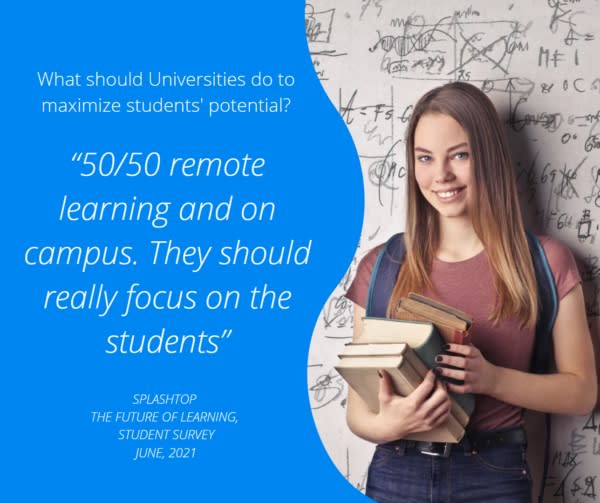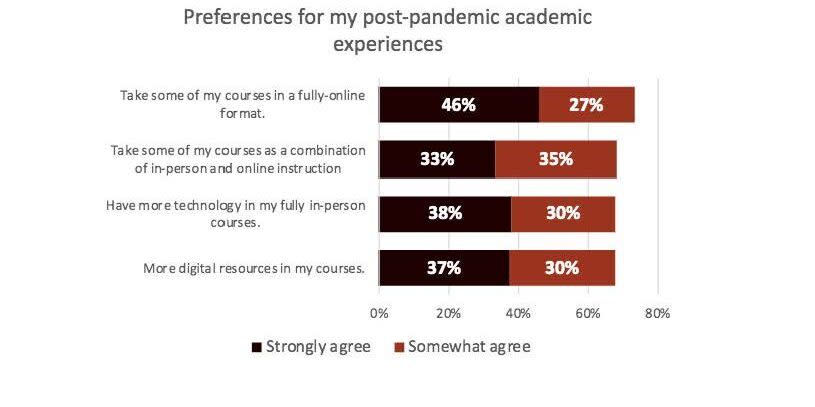Technology has a tendency to redefine how we do things in our everyday lives. While academic institutions have remained mainly traditional, it only took one year of the COVID-19 pandemic, for technology to change the world of education forever.
The pandemic has forced higher education institutions—strongly based on traditional, face-to-face interactions—to suddenly grab whatever remote technologies they could cobble together on a moment's notice.
IT and operations leaders had to quickly upgrade their school’s tech stack to help faculty and students remotely access critical on-campus resources from home, sometimes overnight.
In fact, Microsoft's CEO Satya Nadella, said that we have seen two years' worth of digital transformation in just a few months due to the COVID-19 pandemic.
However, as the dust settles and many higher education institutions reopen their doors, they are faced with one major question that dictates the future of education:
Should we go back to how things were pre-pandemic or offer blended learning options where students have access to both remote and onsite coursework and on-campus resources?
To answer this difficult question, we must start by understanding what students want.
What Students Want – Insights From Splashtop Student Survey

* Source: Digital Learning Pulse Survey by Bay View Analytics
We asked 500 random students around the world what the future of learning looks like to them including what universities could do to maximize their potential. Most answers leaned towards better leveraging technology for hybrid learning environments.
Students want "50/50 remote learning and on campus."
In this same Splashtop survey,
56% prefer to take more than half of their classes online
85 % said they would be more efficient if they had continuous access to campus computers remotely
83% think a mix of online and on-campus learning is the future of education
In a recent press release, we further evaluated these findings and found that the outcomes from the Splashtop Future of Education survey are well aligned with many other studies on the future of education.
This includes the Digital Learning Pulse Survey by Bay View Analytics, which surveyed 1,413 US students who were registered at a higher education institution in the fall of 2020 and spring 2021 semesters.
The Digital Learning Pulse Survey also highlighted that moving forward; most students would like to have hybrid learning options and more technology integrated into their coursework.

* Source: Digital Learning Pulse Survey by Bay View Analytics
Hybrid Learning - The Rising Interest From Students
1. Increased flexibility for students
Hybrid learning programs offer more flexibility than on-campus classes. Rather than attending class on campus every week, students can complete more than half of their assignments asynchronously in a hybrid distribution scheme. This could be a blend of online and onsite classes or hybrid classes where students do some of their work online and the remainder onsite with their teachers.
According to Best Schools Magazine, the improvement in flexibility also allows institutions to adapt learning to various student learning styles: "Auditory learners can benefit from the ability to rewind recorded lectures, [..] visual learners can study slides at their own pace," and "students who benefit from in-person meetings can still connect with their instructors and fellow students."
In a hybrid learning environment, students have the flexibility to remotely access campus resources like the computer labs at any time without leaving their homes. In other words, hybrid environments allow students to benefit from the best of both onsite and remote learning.
2. Wider access to learning
Many international students had to take a gap year because they could not attend their universities in person due to the COVID-19 travel restrictions. Hybrid learning programs, enable these students to enroll in remote learning classes regardless of their proximity to campus.
A hybrid learning program facilitates continuous education during various emergencies that can range from a pandemic to more likely scenarios like a blizzard where the campus is closed. Hybrid learning opens doors for students who are far from the campus and provides universities with the opportunity to enroll students who are no longer limited to a geographic location.
3. Developing digital literacy
In a hybrid learning environment, students are exposed to diverse technologies that facilitate hybrid learning.
This exposure occurs when students use software for an assignment or learn how to use an online management system to access learning resources. Experience can also be gained by communicating and collaborating through technologies like Microsoft Teams, or remotely accessing on-campus lab computers software like Splashtop.
Ultimately, these accumulated experiences with remote learning tools enhance students 'digital literacy skills, a growing essential skill in the professional world.
What Students' Interest in Hybrid Learning Means for Higher Ed
With an increasing number of students showing interest in hybrid learning programs, universities should continue to incorporate these initiatives into their post-COVID curriculum.
It not only can increase enrollment but also enhance and expand access to higher education for students who are unable to attend classes in person.
According to a Harvard Business Review article, the shift towards hybrid learning is long overdue: "Higher education has significantly lagged behind other industries in moving to a more digitally-driven [..] model."
The pandemic has changed the face of education, and with the benefits made clear, many, universities are moving towards a hybrid model.
Setting Up an Effective Hybrid Environment in Higher Ed

Setting up an effective hybrid learning environment in higher ed starts with having the right tech stack.
Before the pandemic started, higher ed institutions dedicated less than 5% of their budgets to IT spending. Hybrid learning environments were either very basic or non-existent. When remote learning became the default in 2020, many colleges and universities were limited to switching to remote education with live Zoom classes.
While video conferencing software like Zoom is essential in a remote learning environment, it is not enough.
In addition to video, there are four additional types of remote learning software that higher ed institutions should invest in when creating a hybrid learning environment.
1. Learning Management System (LMS)
Learning management systems provide teachers with a way to automate the delivery of course material in a virtual format. Popular Learning Management Systems include Schoology Learning, Canvas, and Blackboard Learn.
2. Collaboration and Coordination Software
With remote learning, it can be challenging to coordinate the tasks of multiple people. Collaboration software can help students and teachers work together better in a remote environment. Some of the most common collaborative software tools include MURAL, Drawp for School, and Loop.
3. Remote Access Software
While working from home, some students may lack the high-end software tools they need; including Adobe, Revit, AutoCAD, and Microsoft Office. Remote access software like Splashtop for Remote Labs enables schools to give students remote access to Windows and Mac computers from their home computers, tablets, Chromebooks, and even mobile devices. As a result, students can remotely access all the high-end campus software they need without additional licenses or making a trip to campus.
4. On-Demand Remote Support Software
Due to the nature of distance learning, it can be challenging for academic IT help desk teams to provide technical support to students and faculty. When individuals are not on campus, there are not many options to receive assistance with technical issues on their devices. Remote Support software like Splashtop SOS offers a way by enabling IT technicians to remotely access students and faculty devices and provide on-demand remote support.
While this list is non-exhaustive, it provides a great foundation for setting up a hybrid learning environment in higher education. As we move towards a more digital educative world driven by a generation of more tech-oriented students, universities will need to continuously adapt to remain relevant to student's needs.

